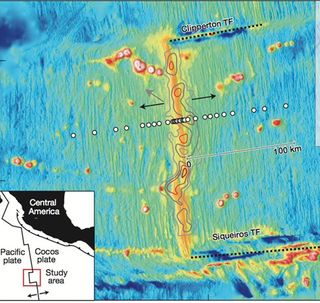
Rare View Reveals How Earth's Crust Forms

One of the Earth's best-ever baby pictures reveals how crust forms at the biggest volcanic feature on the planet.
The detailed look at molten magma beneath a mid-ocean ridge, one of the giant undersea cracks that ring the globe like seams on a baseball, sheds light on the driving forces behind plate tectonics. The results of the study are published today (March 27) in the journal Nature.
Most of the Earth (70 percent) is covered by oceanic crust, mainly basalt, formed from lava that burbles out ofmid-ocean ridges. The ridges run across some 40,000 miles (65,000 kilometers) of the seafloor. They mark where crust pulls apart, leaving space for hotter mantle rock underneath to rise up and melt.
But the particulars of this process have been fuzzy. Geoscientists lacked clear images of structures beneath the mid-ocean ridges, which would reveal how magma moves to the surface.
"The upper mantle melting region is a deep and difficult target," said Kerry Key, lead study author and a seismologist at the Scripps Institution of Oceanography in San Diego.
Key and his co-authors peered into this mysterious zone beneath the northern East Pacific Rise, a fast-spreading mid-ocean ridge near Costa Rica.
Plates pull apart, make new crust
Sign up for the Live Science daily newsletter now
Get the world’s most fascinating discoveries delivered straight to your inbox.
Their new image is akin to a sonogram of the Earth, but instead of sound waves, the researchers used a technique called electromagnetic imaging, which looks for subtle variations in Earth's naturally occurring electric and magnetic fields. The variations reveal different layers and liquid beneath the surface.

Key discovered a symmetrical, narrow melt zone beneath the East Pacific Rise. This implies the mantle is simply filling space created by spreading plates, he said. If the rising mantle were pushing the plates apart, there would likely be evidence of localized convection, such as broader, asymmetrical melting.
The study supports one of the dominant theories (the passive flow model) of how mid-ocean ridges work, the researchers said. Earth's crust is like a giant conveyor belt, with plates spreading apart at mid-ocean ridges and diving into the mantle for recycling at subduction zones, Key explained. The plates ride on giant convection cells in the mantle, but mid-ocean ridges aren't linked to these massive swirls. Instead, the ridges' localized melting comes from the space created by slip-sliding tectonic plates, geologists think. However, there's ongoing debate as to whether the driving force is pull at subduction zones — the passive flow model — or push from magma coming up at ridges. [Infographic: Tallest Mountain to Deepest Ocean Trench]
"Our data looks just like the passive flow model," Key told OurAmazingPlanet. "It agrees with what everybody thinks should be going on, but we haven't had a good image before. It looks like something somebody would have drawn in a textbook based on what we thought was going on."
How the mantle melts
The results also confirm models of mantle melting based on rocks scraped off the seafloor at mid-ocean ridges. Sometimes, pieces of the mantle are carried up to the surface with erupting lava, giving geologists a glimpse into this inaccessible part of the Earth.
The first gooey mantle rocks to melt have a high concentration of impurities, such as carbon dioxide and then water, Key said. Finally, between a depth of 37 miles (60 km) and the surface, the melt really gets going, with about 10 percent of the mantle transformed to liquid rock. Just below the surface, a vertical channel to the east of the ridge connects the magma reservoir to the fissures and volcanoes at the surface.
"This really helps to fill out the picture of how ridges work and how the melt gets from where it's formed to the surface," said Don Forsyth, a marine geophysicist at Brown University, who was not involved in the study.
However, Forsyth would like to see additional surveys along the north-south ridge axis to confirm there's no mantle convection. "I think they have strong supporting evidence for passive upwelling, but the symmetry by itself doesn't necessarily prove that it's passive," he told OurAmazingPlanet.
Email Becky Oskin or follow her @beckyoskin. Follow us @OAPlanet, Facebook or Google +. Original article on LiveScience's OurAmazingPlanet.

Most Popular

